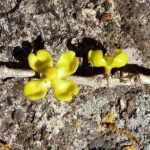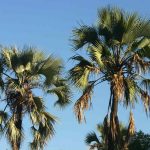TREE LIFE
DECEMBER 1990
MASHONALAND CALENDAR
Tuesday 4th December: Botanic Garden Walk. Park your car at the Herbarium where we will meet Tom Muller at 1645 hours for 1700 hours.
Sunday 9th December: Our annual Christmas social which this year will be held at John and Myra Jones bird sanctuary in the Widdecombe/Epworth area promises to be exciting because Dr. Kim Damstra is working on a fiendish arboreal quiz. So bring some Christmas fare with your lunch and enjoy a relaxed day at this lovely spot which has a river, plenty of boulders, trees, birds and peace. A braai will be lit if you would like to bring your steak and boerewors. We will meet there at 1030 hours.
Tuesday 25th December: The Chairman and Committee wish all members and their families a joyful and peaceful Christmas.
Saturday 29th December: There will be no walk this month as Mark will be away.
MATABELELAND CALENDAR
Because of the very erratic postal service to parts of Bulawayo of late would Matabele members please advise the Editor at P.O. Box 2128, or via Ken Blake, of the date of receipt of this issue of Tree Life. We will try to pin point the cause of delay with a view to rectifying the situation.
On Sunday December 2nd: We go to Sunrising, one of Bulawayo’s stately homes, owned by Anglo American by courtesy of Mr. Graham Paxton. This is situated next to State House, along the Falls Road, 4km from the City Centre. Meet at 0830 hours outside the German shepherd Dog Club, next to the Crematorium, Lady Stanley Avenue. Please be on time, NO stragglers, for the convenience of the State House Security Guard. Morning only. Bring tea and chairs.
On Tuesday January 1st: We will have our New Year Party, with the Blakes, in Glenville – Phone 62229. The trees are waking up and the river is running. From 1130 hours.
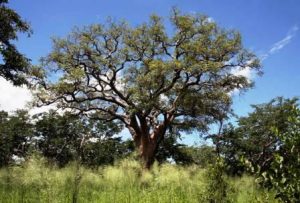
Ricinodendron rautanenii. Photo: Bart Wursten. Source: Flora of Zimbabwe
On Sunday November 4th we went up the Falls Road to Sun Valley/Mkondo Far, to Mr. Charles Stirling. Here we were met and guided by an old friend, Andy Williams. In spite of the heat, we covered a lot of ground and found some fine trees, but being Kalahari Sand, not many different species. Although there was a river frontage, the Umgusa, it was pretty dry, and the camps had mainly under ground water. There also was a fine Citrus orchard.
We found seven Acacia species – A. arenaria, A. erioloba, A. fleckii, many A. karroo, A. nigrescens, A. nilotica, A. rehmanniana, Albizia amara, A. antunesiana, one very large, in the orchard, some teak Baikiaea plurijuga, Bolusanthus speciosus, Burkea africana, Cassia abbreviata, Cassine matabelica, Combretum apiculatum, C. erythrophyllum, C. hereroense, C. imberbe, C. psidioides, Dichrostachys cinerea, Diospyros lycioides, widespread, Euclea divinorum, Gardenia volkensii, Grewia retinervis, Lonchocarpus capassa, Maerua juncea, Ochna pulchra, Rhus pyroides, Ricinodendron rautanenii, some fine specimens, singly, here and there, Securidaca longepedunculata, some in flower, Sclerocarya birrea, Strychnos pungens, terminalia sericea and Ziziphus mucronata. Altogether a good but exhausting outing.
-C.Sykes
THE VUMBA IN FLOWER : OCTOBER 21st – 26th 1990
In most parts of Zimbabwe October is a good month for trees in flower. In late October, we visited Seldomseen in the Vumba, staying with Alec and Cecilia Manson, and it was an interesting opportunity to see whether the trees of the submontane forests were also flowering. In general, flowering was not spectacular. Flowers were not easy to find and were usually white, green or yellow or some combination of those colours and therefore were not very striking. Never the less, in all, 23 species were seen in flower at Seldomseen. A few of the more noteworthy species were as follows:
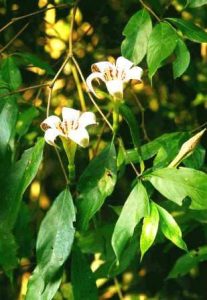
Rothmannia urcelliformis. Photo: Bart Wursten. Source: Flora of Zimbabwe
In the forest, Rothmannia urcelliformis (RUBIACEAE) had large white corollas with purplish markings on the outside. Fallen blooms smelt noticeably unpleasant. The delicate white flowers of Carissa bispinosa (APOCYNACEAE) were quite common. In the FLACOURTIACEAE, Aphloia theiformis was covered in small whitish flowers with prominent stamens, a specimen of Rawsonia lucida was found with a solitary white flower and Kiggelaria africana was discreetly showing its pale greenish flowers.
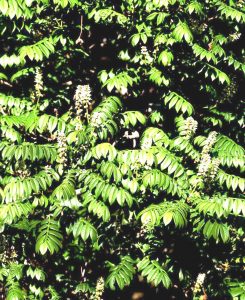
Bersama abyssinica. Photo: Bart Wursten. Source: Flora of Zimbabwe
A very attractive species on the forest margins was the climbing Canthium, Canthium queinzii (RUBIACEAE) which has club shaped stigmas exserted from yellowish white flowers arranged in clusters along the top of its arching stems.
Perhaps one of the most attractive trees seen was Bersama abyssinica (MELIANTHACEAE) growing by the main Mutare to Vumba Road, below the Essex Road junction. The tree was covered in large, upright, conical flower spikes and was most striking in appearance.
In summary, it was an interesting week and I am most grateful to Cecilia Manson for naming many of the trees seen.
-M. Hyde
POTTERING AT THE GAMBIERS ; 18TH NOVEMBER
Forty people, including some members of the Aloe and Cactus Society turned up at Sitra, in the Bromley area, to sample the delights that Nick and Mandy Jeffreys had laid on for us. Nick had checked out a 3km walk through the bush, but such was the variety of trees that Phil Haxen hardly covered more than 500 metres before the morning had gone.
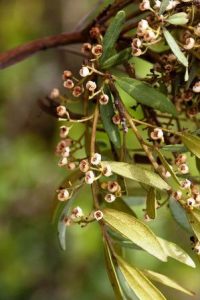
Euclea crispa. Photo: Bart Wursten. Source: Flora of Zimbabwe
So many species were either flowering or fruiting. We found Psorospermum febrifugum flowering profusely next to Euclea crispa, also flowering, a species not well known to many present. Fruiting heavily were the many Parinari curatellifolia with ample windfalls for the curious to try. Vitex payos was just beginning to flower, with one white and one blue petal. There were no Chocolate Berries yet, but the heavy flowering bore promise of many to come. Both Strychnos spinosa and S. coccculoides were found fruiting, the former with a uniform green capsule and the latter having a mottled one. S. spinosa was found flowering with very small fruit already forming. Do the unfertilised flowers in the head abort when one becomes fertilised? It seems likely, the stalks seem too fragile to support the weight of more than one mature fruit.
We found Vangueriopsis lanciflora bearing many large fruits often with an asymmetrically positioned persistent calyx, and Rhus longipes bearing large sprays of very small orange brown fruits. Underfoot were many clusters of red fruits of Lannea edulis and high overhead larger clusters of Loranthus sp. waiting to be taken by birds in the hope that when the birds wipe their bills on the branch of another tree to get rid of a sticky seed, they will embed that seed in a crack in the bark, effectively establishing a new parasite.
After lunch under an enormous Erythrina abyssinica in Nick and Mandy’s garden we went across to the showroom to admire, and to buy, the products of Sitra Potteries. Early signs of the Christmas spirit were evident, the cash register rang cheerfully, and then most people called it a day. However, Phil and a band of hardy souls climbed a small kopje behind the Pottery, what they found there is shrouded in mystery, as the writer sped home just missing a rainstorm that moved up the Blue Waters Road.
This was a most instructive and entertaining day, and our grateful thanks go to Nick and Mandy, and Phil for making it so.
-E.R.R.H.
NYARUPINDA CATCHMENT : BACKLOG OCTOBER
The impact of returning to Zimbabwe early in October was powerful after being away for five weeks overseas. It was a shock to see how much of the countryside was blackened by veld fires in this area, the most we have ever seen.
A few notes about October because it was abnormal. By the end of the month it was clear that it was the melting pot of all the seasons; Spring’s bud burst, flowering and fruiting in the hot, still atmosphere. Summer’s growing weather for a day or two when 7mm fain fell on the 21st of the month. Autumnal winds did not come when expected but came late causing uncontrollable fires. There have been starry winter nights when the temperature has dropped to 12 degrees.
On a calm evening after the first day of examinations Katawa Primary School burnt down, only Grade 1 and 2 classrooms remained, all the contents were moved to safety and no one was hurt. The blazing thatch could be seen for miles around, it was frightening to behold and we were compelled to watch until the flames died down. Exams continued and lessons went on under the trees when the roofless classrooms got too hot. The real hardship will be felt when the rains begin. We cannot help wondering if it was an accident.
Catching up on what has been happening in the Catchment has been joyful in spite of some scorching hot days. Having seen and smelt the perfume of Pod Mahogany flowers nearby it was opportune to visit some Snake Bean trees which grow in the sand veld on Katawa, expecting to find flowers, it was too early, there were plenty but unopened. It is thought that the genus Swartzia to which Snake Bean belongs is intermediate between the subfamilies to which peas and Cassias belong, i.e. PAPILIONOIDEAE and CAESALPINIOIDEAE. Samples of this wood are a ‘must’ in a collection of African hardwoods.
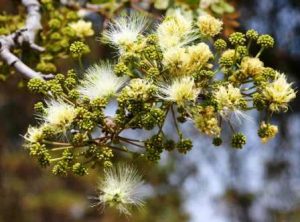
Albizia antunesiana. Photo: Bart Wursten. Source: Flora of Zimbabwe
New blooms found on 17th October were those of Albizia amara and A. antunesiana, then those of wild Gardenia, Violet Tree, Duiker Berry, spectacular Acacia goetzei abound this season as do Jasminum stenolobum. The Ochnas have finished flowering, the young O. gambleoides near the house made one cluster of fruit last year and now bears five clusters, it is growing well.
On another occasion we rode to the watershed of the Nyarupinda and Dora rivers on Dalston farm where we rested and then looked at beautiful trees amongst granite rocks where a house is being built.
Pink fruits of Terminalia sericea have blown in the doorless openings and flutter among rocks inside the house. Cabbage Trees, Cussonia arborea are outlined against Wild Apricot and Wild Figs to good advantage. There will be heavy shade and speckled shade in the garden which needs little to beautify it, as there are Pod Mahoganies and Erythrinas on the site. Near the path to the house a Commiphora has just emerged from dormancy, both it and the Sycomore Fig close by, have Biblical connotations which enhance the aura of this secluded place. On the way there, in a vlei, a waterbuck caught sight of us and we got a glimpse of it. This year the small sour plums are early and there are some on small trees which have become like lianes, the nearly translucent fruits light up against a background of shadows. Another attempt is being made to prepare Ximenia seeds so that they will burn like a candle. On leaving Dalston several showers from the irrigation sprinklers were welcome and the horses enjoyed the softer going. The journey home, downhill, mostly, only took an hour at a walk. It was hot by then and we sponged the backs of the horses with salt water before turning them out. It was a relief to be home and to wallow in the warm and cold patches in the pool.
OPERATION CATENA – The objective of a walk was to note the sequence of vegetation for two kilometres along the boundary fence of Nyarapinda Extension and Chepstow Farm. This began at the foot of Kashawa kopje and ended at the Nyarupinda dam. The line ascending the kopje will be recorded with an escort because it is frequented.
A surface examination of the soil was made at each stopping place every 100 paces. At every halt a list of vegetation nearest and within a small radius was noted, sometimes there was only grass and/or sedges.
The terrain varied and the vertical distance between the beginning and the end of the line was less than 30 metres.
Frequently occurring species were given numbers and these became easy to memorise, less common ones were noted in shorthand way but received a number if they became frequent. It would be very tedious to give the results of this exercise which was worthwhile and led to a greater understanding of the vegetation and soil types along this line in the Nyarupinda Catchment.
This exercise included a brief description of the terrain at each halt, e.g. quartz outcrop, closed woodland on level ground, vlei margin, centre of vlei, sparse woodland with grasses, etc.
A knowledge of the grasses would have made this research more valuable because they indicate the fertility status of soils.
The line selected is of particular interest on account of there being three different parent materials forming the soils, granite, dolerite and quartz. There is a fair amount of poor, shallow, eroded soil down towards the dam where shrubby Custard Apples and some herbaceous legumes have taken over in the absence of competition.
Now that this upper storey of vegetation has been recorded, more species can be added as they appear at various levels, season by season. The occurrence of bare patches of soil is the environment for some of the most unusual species of plants whose lives above ground are short term, these have perennial underground parts, e.g. tubers, corms, bulbs. Ground orchids belong to this category, three species are already in flower now, they belong to the genus Eulophia.
At one halt there was a long delay because of a hungry family of Striped Kingfishers in a hole in an old Munondo tree. One of the parents had the slender kind of scorpion in its beak. It chose several perches nearby, it seemed only a matter of minutes before it fed the nestlings. The Kingfisher often adjusted the position of the food in its beak, when held in the tip it was ready to be popped into the hole, surely. The bird flew away up to the electricity line, then made a big show of eating and swallowing the scorpion. It was time to move on, one hour had passed, would the morsel have been disgorged to feed the young?
The screech of the night apes close to the house is a regular occurrence in recent weeks. There are sweet ripe fruits on Diospyros kirkii, Olax obtusifolia, Uapaca kirkiana, Uapaca nitida and Zanha africana; there are many paw paws nearby. Torchlight searches have not been successful in locating these animals. It would be an achievement to find out what attracts them here at this time of year.
The wind is still blowing and signs of rain are eagerly awaited. The Jacobin Cuckoo has called. A Solifuge spider has temporarily taken up residence here and makes a dozen or more identical circuits under the sofa on which I sit with feet up. So inquisitive, climbing and throwing itself down.
The Catena walk revealed several Pericopsis angolensis beginning to flower, some pods still hang on. Plump orange/red seeds are in the pods of the tree which receives extra water, these ones are saved for the Herbarium. Dry land Muwangas appear to have flat, pale coloured seeds, their germination seems doubtful. The Elephantorrhiza goetzei bears young pods, they are conspicuous, greenish mauve and feel like plastic. This tree looks cool at the foot of Kashawa Kopje.
-Benedicta Graves
MUKUVISI WOODLAND NOTES
In so far as these notes are concerned, I seem to have joined the ‘chair borne’ brigade. Composition becomes more and more a desk exercise, I find less and less time to get into the woodland. This is bad.
Except to lead guided walks, in the last half year I have only managed two forays into the place, both brief, one to look at the ‘Cinderella’ in the woodland administration, the Blatherwick Road area, and a quick trot through the fuel wood collection area to see how bad it is. Worse, I have missed the last two rostered walks having been out of the City.
However, the weather tells me what it is like in the woodland and it now (mid November) looks like a late start to the 1990 rains. I can pretty accurately visualise how it is in the woodland, even though I have not been there since the end of September, just at the right time to welcome back the European bee eater vanguard.
I love these birds. They chart the seasons. For long I have kept record of their arrivals and departures. They also chart progress of the rainy season but rather on the same basis as the old English country lore ….. “If you can see those hills you know it be going to rain. If you can not see them, you know it be raining!”.
Some six months ago I postulated a sustained lowering of ground water levels in the Mukuvisi. I theorised possibility that too many boreholes were in effect pumping the catchment area dry.
This is largely based on observation of the underground water courses across the Chiraura Vlei. My latest impression is that this trend is still going on and I am beginning to think that a prime factor might in fact be an increase in the biomass in the form of woody vegetation.
Lets hazard a guess, perhaps that part of the biomass composed of woody vegetation is three times greater in volume than it was a decade ago. This is conserving more water in the living plant materials, it is also increasing loss into the atmosphere by transpiration.
If this is so, the increased bulk holding moisture negates the greater penetration of rainfall into the soil caused by bio mammal trampling and also the beneficial effect of our two dams which must in fact have some influence on raising ground water levels in the catchment.
At one time I used to doubt the possibility that natural savannah woodland could lower water levels in soil by transpiration. No longer; I have seen too many examples of fluctuation in stream flow which I have only been able to relate to leaf fall or conversely new spring growth.
One plant in the woodland which is rapidly extending its range, (speaking relatively) is the dwarf Parinari capensis, this I have no doubt is the result of removal of competition from grass by relative over-grazing.
-G.Hall
CHIRINDA FOREST -RICH SPECIATION (continued)
Now, with some of the geographic and historical background before you, let us have a look at the rich speciation of Chirinda.
Trees
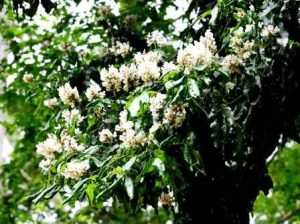
Craibia brevicaudata. Photo: Bart Wursten. Source: Flora of Zimbabwe
Of the trees, 13 are in the family EUPHORBIACEAE, and 12 RUBIACEAE. The latter are mainly middle storey trees. 30 or more families account for the remaining 70 species. Here one can see the evidence of relic forest, because many trees are rare to Rhodesia but known in Central Africa, Mozambique, South Africa or Madagascar.
Most commonly seen are Chrysophyllum gorungosanum, Craibia brevicaudata and Trichilia dregeana. All exceed a metre in diameter and reach up to 150’or more.
Mushrooms
Mushrooms alone offer great scope to any botanist or ecologist who cares to study them. In Chirinda they come in as many hues as Joseph’s coat, apart from the varied textures and shapes. A doctorate is there for the taking. I have always been disappointed at the lack of knowledge of our fungi except when they are economically involved. Colour photography would be needed, or better still artistic ability. Have any of you, camping in the Eastern Border forests, accidentally disturbed the leafy litter in the dark of night to discover a glowing phosphorescence? Quite uncanny. Caused, I believe, by a fungal body invisible to the light of day. Many fulfil a role in breaking up fallen logs which still contain sucrose and nutrients. I do not think the fungi attack healthy plants. In the case of the Big Tree it is over mature and will eventually fall to create a gap in the canopy. This will quite quickly be filled by other tree species. Borers big and small break down wood remarkably quickly once the moisture content has dropped sufficiently. This cycle of decay enriches the soil, thereby ensuring survival of the forest trees. Rootblow is the commonest cause of tree fall. In this rich endowment, large trees are surprisingly shallow rooted.
Animals
Large rounded hollows, now covered with big trees, are said to have been elephant traps of bygone days. More recent rectangular pits are definitely evidence of the work of pit sawyers. Petrodromus tetradacytylus swynnertoni, this intriguing name represents a delightful rodent found in the forest margin. Literally translated, the name means “A rock dweller with four toes, of Swynnerton” swynnerton’s Forest Elephant Shrew grows to 20cm long with an 18cm tail. My wife once raised one by feeding it diluted milk from an eye dropper. At this stage it was a tiny naked being. It thrived and grew into a termite loving, completely tame animal. Its ears are rounded, large, distinctly veined. Limpid brown eyes, a long whiskered nose and very long delicate back legs made it a most endearing pet. As if this were not enough my wife discovered that behind each eye is a perfectly luminous dot. This must surely be unique for any furry animal. It is probably a recognition spot in the forest gloom. “
Shrewddie” would cheerfully sit on a termite mound to devour soldier ants. The heads were always crushed to eliminate a bite from the nippers. Everything was swallowed headfirst. Given a live Hawk Moth she would stand upon her hind legs, whereupon a battle royal would start until the victim was subdued. Although a little diurnal in her habits she would come to life in the evening. Walt Disney would have got inspiration from this quaint creature. When I questioned Dr. H. W. Setzer about the luminous dots he was evasive even though his party had slaughtered many specimens. He had no answer even when a photograph was produced as proof. Dr. Setzer visited Chirinda on a collecting trip, as head of the Mammal Department of the Smithsonian Institute of America.
The Samango monkey is essentially a forest species. Big males are handsome with long black-green fur. They emit a deep explosive boom when disturbed. The young twitter like birds. As tree dwellers they move in large troops eating fruits mainly. So ingrained in their dislike of touching ground, they will jump wide gaps from tree to tree in a downward direction, never failing to find a hold. Their flight is upright with arms and legs outstretched. Very shy and almost impossible to trap. A group of youngsters will wrestle one another on flat tree tops in a most amusing human fashion. The common nearby Vervet is much smaller. Like the Baboon he shuns the forest. Samangos enjoy basking in the early morning and late evening sunlight.
Bush babies are creatures of dense forest. Their cuddly woolly appearance is appealing but they are indolent and sleepy during the day, being completely nocturnal. Mainly fruit eaters with a liking for alcohol, fortunately not found in the wilds. They are not confined to Chirinda but the tree veld Night Ape, which is much smaller, does not venture into the forest.
The brown sun squirrel can only be seen high in the forest canopy. His handsome cousin, the Red Squirrel uses the forest floor a lot to forage. In sunlight a good specimen is auburn. As it moves into the shade this colour changes markedly to almost black. It disappears in a flash when disturbed, usually into a tree stem hollow. The bush squirrel does not enter the forest.
Palm Civets as big as tomcats, leave the forest at night. Uniformly brown, they live on fruit mainly, but local Africans insist they will kill chickens. We had no proof of this.
The Gambian Rat, which occurs in Salisbury lives on fruit and roots. A pest in vegetable crops but easily trapped. It is easily tamed. I measured one which was 26” from tip to tip and weighed four pounds. A parasitic insect lodges itself in the hairs to feed off the body; a monotypic genus and species confined to Gambian Rats.
Two large mice were discovered in Chirinda in 1938 by Austin Roberts, Aethomys selindensis. They are unique in having five-rooted molars. No trace of this species has since been found.
Blue Duiker, a miniature antelope, has blue grey fur prized for karosses. Not much bigger than a large rabbit, this elegant horned creature is truly beautiful. Unfortunately easily trapped by wire nooses set in their well marked trails. The common duiker does not venture into the forest. To be continued.
-B. Goldsmith
DICK HICKS CHAIRMAN


